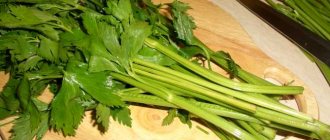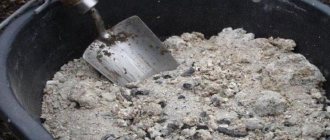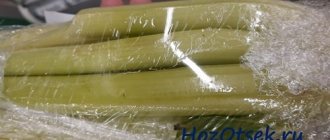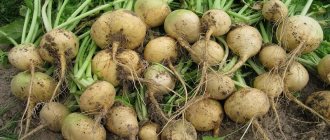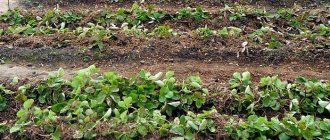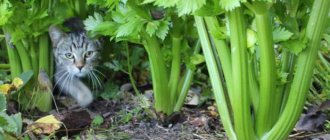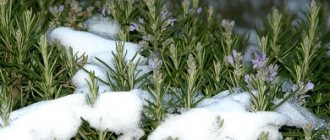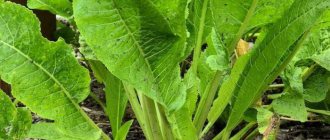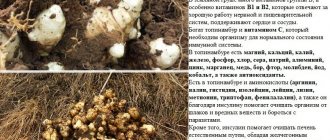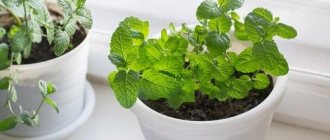Only the lazy don’t talk about the benefits of celery. Freshly squeezed juice from the petioles is rich in vitamins and promotes weight loss, improves complexion, and has a calming effect on the nervous system. The vegetable contains carotene and is rich in valuable amino acids and microelements. If you managed to grow this crop on your plot, the question arises of when to harvest and how to store petiole celery so that it retains its healing properties and brings maximum benefits.
Juicy stems are good in fresh salads, soups, side dishes, they are used to prepare vitamin cocktails
When is it time to dig up celery roots?
Root celery is a short-day plant with a long growing season (120–150 days). It is on cool autumn days that the vegetable begins to actively grow and accumulate nutrients. In hot summer weather the crop hardly grows.
Deadlines
It is important to harvest root crops in time in order to prepare them for transportation and storage. They must ripen well, otherwise they will be tasteless and quickly become unusable. Due to the delicate peel, the root crop is prone to withering and rotting.
The vegetable is resistant to cold and even slight frosts on the surface, so do not rush to harvest. It is usually harvested in the second half of October.
Late varieties of root celery actively gain weight, taste, accumulate nutrients, and form a peel in October and early November. At the same time, you should not delay the event until real frosts, since the taste of frozen vegetables changes greatly.
Advice! If the celery is caught in frost before harvesting, it is not immediately brought into a warm place, but left at a positive but low temperature, no higher than +10°C, so that it does not rot.
Experienced gardeners recommend harvesting celery after a good rain. If the weather is dry, the beds are watered. Then, when digging up root crops, it will be possible to avoid their damage, which will affect the keeping quality.
By what signs can you understand that it is ripe?
The color of the tops will help determine the degree of maturity of root crops. If it starts to turn yellow and dry out, it means the celery has stopped growing and it’s time to dig it up.
Product properties
The chemical composition of celery is rich in vitamins and microelements. It contains compounds of groups B, A, E, K, even ascorbic acid. Particularly valuable are riboflavin and thiamine, which are accumulated by the plant in the petioles and leaves. From celery you can get apiol, which is rare in plant products. The root part contains difficult-to-digest proteins and choline, the leaves are rich in nicotinic acid.
Benefit
Once in the digestive system, these compounds begin to act actively:
- the secretion of gastric juice increases;
- the stability of body cells increases;
- the nervous system calms down.
The vegetable is especially useful under significant mental and emotional stress. It helps strengthen the system, calm down and restore strength.
Celery is especially useful for men. It stabilizes hormonal levels, lowers cholesterol and improves blood counts. One of the beneficial effects is lowering blood pressure. It needs to be consumed fresh to get these results.
Even in dried form, in the form of a seasoning, the vegetable has many beneficial properties. It preserves its essential oils in high concentrations. This is an excellent diuretic that will help normalize the functioning of the kidneys and liver, cleanse them and avoid stagnation of fluids.
A vegetable is unique: each part of it has a special chemical composition and is valuable in certain vitamins and microelements, so it cannot be said that greens or roots are healthier. The leaves contain the largest amount of essential oils, in addition, about 70 percent of vitamin A is concentrated in this part of the aerial part. The root contains about 75 percent of the vitamin K contained in all celery, in addition, it is an essential source of copper, zinc, selenium and phosphorus, which are practically absent in the green part. The stems, the so-called petioles, are also valuable. They contain calcium, magnesium and sodium.
Possible harm
Since all parts of the plant contain so many different vitamins and minerals, celery can be considered an active dietary supplement of natural origin. In this regard, it is worth remembering some contraindications:
- lactation period;
- pregnancy;
- epilepsy;
- bleeding;
- hypotension.
The vegetable has a positive effect on digestion, however, due to the content of beneficial acids, it may be contraindicated for people with gastritis due to high acidity, and patients with stomach ulcers. Celery can cause allergies.
One of the important properties of the product is its ability to enhance cellular permeability and absorption of substances into the blood and tissues. Therefore, in case of poisoning, after bites of poisonous insects, snakes, it is forbidden to eat it.
Ripening dates in different regions of Russia
The timing of ripening and harvesting of root crops largely depends on the weather conditions of areas located in different climatic zones of Russia, and the varietal characteristics of the crop. It is important to plant a plant that will have time to ripen, and the harvest will be stored for a long time.
When to harvest celery in different regions of Russia:
- The Moscow region is characterized by clearly defined seasonality, high humidity, warm summers, moderately cold winters with stable snow cover and thaw. For these places, mid-early varieties of the crop are chosen, the ripening period of which is 140–150 days. Harvest occurs at the beginning of October.
- The Volga region is characterized by frosts in early spring and late autumn, snowy winters and hot summers, so it is better to plant early and medium varieties here. The harvesting period for celery in this region is September – October.
- For northern regions (Urals and Siberia) with a cold climate and frosty winters, early varieties are chosen for planting, and the harvest is harvested before mid-September.
- In the Krasnodar and Stavropol territories, where the southern climate is warm, varieties of late ripening (about 200 days) are grown. Root crops are dug up at the end of October.
Cleaning time
What is the time frame for harvesting petiole celery? There is no need to rush to remove rhizomes from the ground. After all, the more they are in the ground, the larger and riper they become. Also, over time, the skin of the fruit hardens, as a result of which the pulp of the vegetable becomes reliably protected. It can be easily stored and transported. Under no circumstances should you keep the plant in the ground during frosts. Indeed, under such conditions it will not be possible to preserve the harvest at all.
In temperate climates, celery should be harvested approximately at the end of September. More precisely, the collection period is determined based on climate and weather conditions. When there is a month left before the planned harvest, it is necessary to remove the lower leaves and shoots that have served their purpose. Now the root crop should ripen without its green parts.
To avoid damage to the skin of the crop, it is better to harvest without a shovel. The most successful option is to simply pull the tops out of the soil by hand. Checking the quality of petiole vegetable fruits is very simple - just touch their tops. If this part of the root crop is soft, it means it is starting to rot. Tap the fruit. Do you hear a ringing sound? This means that there is emptiness inside the root vegetable.
Next, you need to trim off the green leaves, leaving behind small stumps. The thin roots should be eliminated, and the vegetable itself should be “freed” from the piles of earth on it.
The harvested crop must be sorted. Are there many fruits? You can leave several specimens right in the garden bed. The underground part of the plant will become unsuitable for consumption, however, at the very beginning of spring, young leaves will appear on the crop. They make an excellent salad. Do you want to grow a vegetable for yourself for the winter? Grow the crop in your window in a regular flower pot.
How to dig up celery root correctly
To avoid damaging the root crops when digging, it is better to use a fork or a flat shovel.
Attention! Simple pulling out is suitable only in case of quick use of vegetables: with this method of harvesting, the root vegetables are severely damaged, which reduces their shelf life.
When digging vegetables, it is advisable to grab a large volume of soil around, then the root system will remain intact. To do this, they retreat 10–15 cm from the root crop, dig it up and, grasping the tops, carefully remove it from the ground with their hands.
After harvesting, the root crops are sorted and their quality is checked: they must be hard, without damage or rot, small healed cracks are acceptable.
Before being sent for storage, the crop is prepared:
- Clean or shake off the soil.
- Wash in water and leave in the sun for 1-2 hours to dry.
- The entire green part is cut off at a distance of 2 cm from the base and left on the bed as fertilizer. When cutting tops, it is important not to damage the growing point.
- To prevent the cut areas from drying out and starting to rot, the vegetables are laid out in a shaded, ventilated area.
- Store in the basement, refrigerator or freezer.
Root vegetables with slight mechanical damage are not suitable for long-term storage - it is better to use them immediately.
Cleaning technology
When harvesting vegetables, try to avoid physical damage to the fruit. After all, in this case it will be impossible to save the harvest. The petiole vegetable will rot quickly. Therefore, cleaning must be carried out as carefully and accurately as possible.
After collecting root crops and cutting off their tops, it is worth sorting out rotten and damaged specimens. Drying it will help preserve celery for the winter. To do this, simply leave the vegetable in the fresh air for several days.
Harvest storage
To keep celery fresh longer, create the following conditions:
- low temperature - 0...+4°C;
- optimal humidity is 80–90%.
Under such conditions, fresh vegetables are stored for 2 to 4 months (in a pit, cellar or basement).
There are many ways to extend the shelf life of a crop:
- In the apartment. In room conditions, the shelf life of celery is minimal - no more than 4 days. To prolong them, choose the coolest and darkest place (for example, a pantry) or place the vegetables in a box mixed with damp sand, cover with cling film and place under the window in the kitchen. The film is periodically removed to prevent vegetables from rotting due to lack of oxygen.
- In the country. They dig a hole, put root vegetables in it in one layer, sprinkle with sand and earth. The method is only suitable for areas with mild climates where the soil does not freeze in winter.
- In a basement, barn or cellar. Vegetables are placed in wooden boxes, covered with sand and lime, covered with sand and covered with clay. When it dries, the boxes are placed on racks and shelves.
- In a refrigerator. Celery is washed under running water, dried and packaged in plastic bags with holes for ventilation. Place in the vegetable compartment and keep at a temperature of +3…+6°C. This will keep the crop fresh and juicy for 10-30 days.
- In the freezer. To freeze vegetables, they are processed, cut into pieces and placed in a bag. Keep for up to 1 year.
Store storage and application of state standards
Petiole celery is packaged in packaging made of polymer materials. They also use polyethylene film in accordance with GOST R 52903, which will preserve it when in contact with the product. Packaging with vegetables is placed in cardboard or wooden boxes in accordance with GOST R 51289. Packaging of celery in the form of bundles is allowed.
One packaging unit must contain products of the same type and shade. All visible parts must comply with the contents of the entire package. The amount of celery in the bunch should be the same.
Place the celery tightly, pressing it a little, but without damaging the root vegetables. The container must be clean, dried and strong. To mark and register vegetables according to GOST R 51074, you need to use glue and markers that are not toxic.
Celery is incredibly popular because it can be consumed throughout the year. You need to choose the right product or grow it at home. If you follow all the recommendations and rules, you will be able to delight yourself and your loved ones with dishes using spicy vegetables.
Harvesting and storing leaf celery
Not only celery roots are used for food, but also other parts: long green petioles and upper leaves . The vegetable is rich in vitamins C, group B, carotene, organic acids, minerals and flavonoids. Therefore, it is important to preserve the value of the plant during harvesting.
Thus, it is recommended to harvest leaf celery before frost, since the leaves wither in the cold, losing all their beneficial substances. They are cut 2-3 times during the summer with an interval of 35–40 days. The maximum time for collecting leaves is late September - early October.
Important! Leaves must not be picked. They are cut with a sharp knife, leaving petioles at least 5 cm long. This will preserve the central rosette, which will grow again, and protect the root system from rotting in winter.
Cut leaves wither very quickly, so they are immediately washed, dried and stored:
- Clean leaves are wrapped in aluminum film and placed in the refrigerator. In this form, the preparation is good for 7–10 days. It is better not to use polyethylene, as after 3 days the greens will lose their color, taste and benefits.
- The greens are laid out on a white paper sheet and covered with the same on top. Over the course of a month, the celery is dried and then used as a seasoning.
- The leaves are crushed, placed in a plastic container and frozen.
- The greens are chopped and sprinkled with salt (100 g per 0.5 kg of leaves). Place in glass jars and seal.
Chereshkova
The petioles of the plant are cut several times during the growing season, when the length of the leaves reaches approximately 30 cm. The most suitable time for the last harvest is the end of September and the very beginning of October. A correctly chosen period allows you to preserve the unique taste of greens. The harvest is prepared for the winter.
Important! The main sign that the petioles are ripe is the appearance of white color and the disappearance of the spicy, pungent taste.
Bleaching is carried out before harvesting. It removes the bitter taste from the petioles and makes them more tender. For this:
- A few weeks before harvesting, the petioles are tied into a bundle.
- The lower part is wrapped in burlap or other breathable material.
- Before cleaning, remove the fabric.
Celery with yellow stalks does not need this procedure, as it is much more tender than other varieties.
How to store petioles:
- In the basement . During harvesting, celery is dug up along with the root so as not to damage it. The plants are wrapped in cloth and left there until they are sent to the basement, where boxes of wet sand are placed. When everything is prepared, the vegetables are placed in the sand. When storing in this manner, it is important to ensure good ventilation.
- In a refrigerator. Leaves and roots are removed from the petioles, washed well and left to dry. Dried plants are wrapped in cling film or foil and placed in the refrigerator.
- In the bank. The roots of the plants are cut off and placed in a jar filled with tap water. They leave it in the kitchen like this.
Celery will last about 7 days in a jar without refrigeration. Be sure to change the water daily and trim the stems a little.
Drying celery
Another way to preserve celery is drying. Like freezing, it helps preserve all the beneficial properties and qualities of the vegetable. Moreover, you can dry both leaves or stems, and root vegetables. In order to properly prepare celery greens and preserve their benefits, you need to remember several features of this process:
- Leaves and petioles can be dried either in crushed form or whole.
- Place the greens in a thin layer on a baking sheet or tray lined with paper.
- Dry, turning occasionally, at room temperature in a ventilated area or under a shelter outdoors.
- After drying, place the seasoning in an airtight container and place it in a dark, dry place. Whole sprigs can be chopped or stored as is.
Even completely dry celery does not change its color, smell and taste for up to 2 years.
You can speed up the drying process using an oven, microwave or electric dryer. The temperature should be about 40 °C.
Properly dried celery stays green, retains flavor, and breaks easily.
You can dry celery root vegetables in the same way. They also contain many useful substances, and the range of culinary dishes using them is very diverse.
Dried celery is a spicy spice that adds flavor to many dishes. In this case, you can dry the plant in various ways:
- dry the rhizomes;
- dry the green part of the crop;
- dry the petioles.
To prepare celery root for the winter, you can use this recipe for preparing dried spices as a basis. For this:
- Select dense, light-colored roots without damage or rot.
- Clear the roots from the soil, wash well with a brush under running water.
- Use a sharp knife to peel off the thick skin.
- Grind the roots in any convenient way:
- grate on a coarse grater;
- chop into thin strips;
- cut into transparent slices;
- chop the vegetable into rings.
Root
- Dry the roots using one of the following methods:
- in the air - spread out on a baking sheet and left in a well-ventilated area without direct sunlight for 14-20 days. Stir the workpiece periodically;
- in the oven - dry the rhizomes at a temperature of 60-70 degrees, placing them in an even layer on a baking sheet with the door ajar. Drying time – 6-7 hours;
- in an electric dryer - at a temperature of 50 degrees, dry the rhizomes for 10 hours. Replace pallets periodically.
To dry the green part of the plant, you need to:
- Sort through the leaves, removing yellowed, wilted and rotten ones.
- Rinse the greens with water and dry.
Attention! You can dry greens using whole branches, leaves or chopping celery.
- Dry the workpieces in one of the following ways:
- in the oven at 50 degrees until the product is ready;
- in an electric dryer at 40 degrees;
- outdoors in a dark, well-ventilated area;
- in the microwave - drying the greens in batches of 2 minutes at maximum power. If necessary, repeat drying after 2-3 minutes.
The recipe for preparing petiole celery for the winter involves sequential steps:
- Sort the petioles of the plant, discarding spoiled, rotten and spoiled specimens.
- Wash suitable stems, dry and cut into cubes 1.5-2 cm thick.
Attention! The finer the plant stems are cut, the faster they dry out.
- Dry the petioles in one of the following ways:
- in an electric dryer at 55-60 degrees;
- in the oven - drying at a temperature of 60 degrees will take 10-12 hours. When drying, you must leave the door ajar and stir the dried stems on the tray every 2 hours.
Dried celery
Advice from experienced summer residents
To get a good harvest, be sure to treat the crop with compounds that protect against slugs (for example, “Thunderstorm”, “Slug Eater”).
To protect celery, the foliage is wrapped in paper or foil. This is especially useful when the plant is very lush. Thanks to the wrapping, the bushes will grow vertically, without falling apart or bending towards the ground.
After any feeding, vegetables are doused with water from a watering can or hose. There should be no fertilizer left on top of the leaves.
Freezing
A very popular method. Despite similar storage conditions, there are significant differences: the presence or absence of heat treatment.
Blanching can be used. The process is similar to processing Brussels sprouts. The action plan is as follows:
- Wash the cuttings, cut out the hard fibers, cut into small or medium pieces.
- Place the chopped vegetable in boiling water for 2-3 minutes.
- Remove the celery from the boiling water and plunge into ice water or ice to quickly cool.
- Place the pieces on a cloth or other canvas in 1 layer, wait for the moisture to evaporate and place them on a baking sheet with parchment.
- Place the baking sheet in the freezer.
- After freezing, transfer the celery to a tight container.
It is not necessary to blanch the celery; just put the chopped vegetables in a bag and put it in the freezer. However, the shelf life will be reduced to 3 months.
Can pregnant women eat celery?
Selection of vegetables for storage
If fruits grown by yourself will be used to prepare supplies for the winter, then you should pay attention to medium, medium-late and late varieties. For example, late varieties Maxim and Anita are best stored. The mid-late ones include Zakhar, Tango and Triumph, and the middle ones include Samurai, Prague Giant and Esaul.
Early varieties cannot be preserved all winter. They are best consumed immediately. Early varieties include the very popular Apple Celery, as well as Snow Globe and Globe.
Attention! In order for the crop to be stored for a long time, you need to choose healthy and undamaged root crops.
When choosing celery in a store or sorting the grown crop, you must adhere to the following rules:
- The root crop should be full, without voids inside. To determine, you need to knock on it; a suitable fruit should make a dull sound.
- A healthy root vegetable should be firm. If it shrinks when you press on the top, rot has formed inside.
- The surface of the root crop should be smooth, without scars, warts or jagged edges.
Salting and marinating
In addition to drying and freezing, you can preserve celery leaves or stalks for the winter by salting. It will not lose its properties for a long time, and in winter you can add it to many dishes.
The process of pickling celery is as simple as other operations:
- Prepare a three-liter jar or container that can be sealed tightly. For 1 kg of celery, take 200-250 g of salt.
- Before pickling, wash the leaves or stems of the vegetable, remove all yellowed parts, and chop finely.
- Toss the greens with salt in a large bowl, then place tightly in the prepared container, leaving room for the juice.
What are the benefits of petiole celery, beneficial properties
A large number of useful elements that make up the plant have a beneficial effect on the human body.
The benefits of celery are:
- Restoring water-salt balance, promoting the outflow of excess fluid from the body;
- General cleansing of the body due to anti-aging and antioxidant properties;
- Increasing the defense capacity of the immune system;
- Maintaining general tone of the body, improving mood, reducing nervousness and tension;
- Preventing the deposition of fat cells;
- Preventing the deposition of kidney stones;
- Inhibition of the development of malignant neoplasms;
- Improving the functioning of the digestive system, cleansing toxins and stabilizing the functioning of the intestines.
The plant is considered an aphrodisiac and is low in calories. Thus, celery is a real storehouse of nutrients for those who want to lose weight.
Tips and tricks on the topic
Experienced gardeners know several secrets for long-term storage of celery :
- The optimal temperature for storing root celery in the cellar is 0...+1°C, humidity is no more than 90%.
- Often, petiole celery is left in the ground until the first frost. To ensure that the petioles remain white longer and do not turn green or become bitter, they are covered with dark non-woven material.
- Leaf and petiole celery is stored together with the root and a lump of earth in the cellar. To prevent the plant from withering longer, it is buried in boxes with sand, which is periodically moistened.
- Celery cut before the flowering period is suitable for freezing. The green part of such plants has a more delicate taste.
To reduce crop losses to a minimum, vegetables are periodically sorted and rotten specimens are thrown away.
